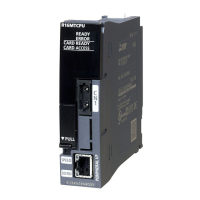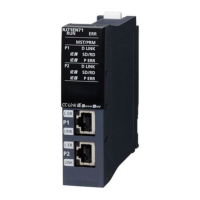4 AUXILIARY AND APPLIED FUNCTIONS
4.2 External Input Signal
99
4
■High-speed input request signal compensation time
Compensate the input timing of the high-speed input request signal. Set it to compensate for sensor input delays, etc. Set a
positive value to compensate for a delay, and set a negative value to compensate for an advance. However, high-speed input
request status outputs the status of the signal with no relation to the set value.
In indirect setting, the timing is compensated as "-5000000" when the compensation time is set to less than -5000000, and it
is compensated as "5000000" when it is set to more than 500000.
If "Estimate calculation" is set to "Invalid" in the mark detection settings, the input timing for high-speed input request signals
is not compensated.
• Direct setting
• Indirect setting
Word devices are used for the high-speed input request signal compensation time. Setting values are read each operation
cycle. Refer to device list for the range of word devices that can be set. (Page 75 Device List)
■High-speed input request signal valid flag
The high-speed input request signal is valid only when the flag is ON. The high-speed input request signal is invalid when the
flag is OFF. This setting can be omitted. When the setting is omitted, the high-speed input request signal is valid at all times.
Bit devices are used for high-speed input request signal valid flags. ON/OFF commands are read when high-speed input
request signals are detected. Refer to device list for the range of bit devices that can be set. (Page 75 Device List)
■High-speed input request signal status
The ON/OFF status of high-speed input request signal can be monitored. ON/OFF status can be monitored regardless of the
status of the high-speed input request signal valid flag. This setting can be omitted. Bit devices are used for high-speed input
request signal status. The ON/OFF status is output each operation cycle. Refer to device list for the range of bit devices that
can be set. (Page 75 Device List)
When signals are input in situations such as the following when the detection of high-speed input request
signals is unnecessary, turn the high-speed input request signal enable flag OFF, and when detection
becomes necessary, turn it ON.
• When "[St.380] Synchronous control (R: M40000+n/Q: M10880+n)" is OFF
• When "[Rq.320] Synchronous encoder axis control request (R: M42241+8n/Q: M11601+4n)" is OFF.
• When mark detection is not used.
■High-speed input request signal control cycle setting
Set the cycle for the detection intervals of the high-speed input request signal, and whether to update the "high-speed input
request signal compensation time" and "high-speed input request signal status" every operation cycle or every low speed
operation cycle.
This needs to be set when using the high-speed input request signal with the mark detection function or clutch control in
advanced synchronous control on an axis operating at the low speed operation cycle. Refer to mixed operation cycle function
for details. (Page 160 Mixed Operation Cycle Function)
When [Motion CPU Common Parameter] [Basic Setting] "Low Speed Operation Cycle Magnification
Setting" is set to "Not Used", this setting is ignored, and the axis operates at the operation cycle.
Precautions
• When high-speed input request signal is set to a sensing module external input signal, set signal type to "sensing module
input". When "bit device" is selected, and a link device that supports external input signals is set, the signal state may not
be correctly detected.
• Do not change high-speed input request signal settings which have "sensing module input" set to signal type by the
parameter change function.
Setting range
-5000000 to 5000000[s]

